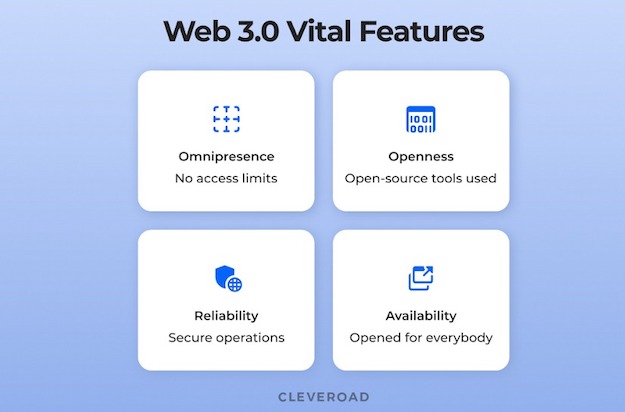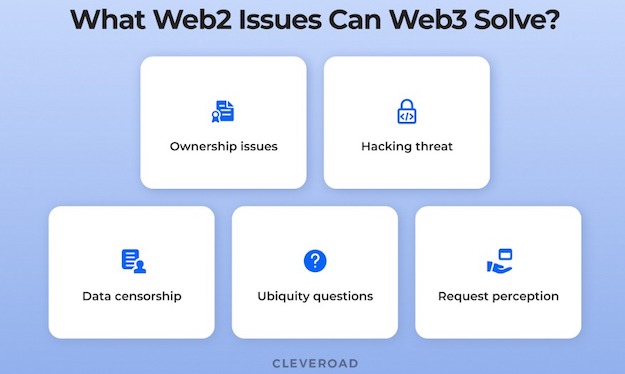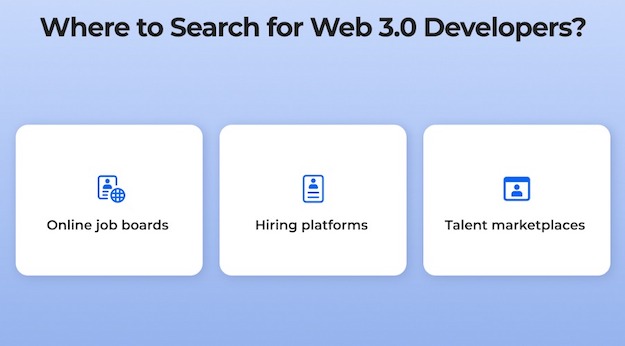Researchers claim that Web.3 will soon replace the current Web.2. Web.3 is an upcoming version of the Internet that will bring many new innovative abilities by implementing AI (Artificial Intelligence), Machine Learning (ML), Big Data, etc.
It’s hard to underestimate the growing popularity of Web3 development. Besides, developers with this particular skill are in great demand. According to Glassdoor, the average US developer that works with Web3 earns around $118,546 a year.
Web3 is a brand new wave in concept and usage of the internet. However, there are still many things to find out, and the knowledge about this keeps expanding.
In this post, you’ll learn the primary purposes of Web3, the challenges you might face, its value, and the tech stack essential in the Web3 development process.
What is Web3 and Why Everyone is Interested in It?
Generally, Web3 is a new phenomenon that sets completely new standards of internet security, structure, and usage. As mentioned earlier, Web3 developers are actively implementing technologies like Machine learning (ML) or Artificial Intelligence (AI) that facilitate faster and more precise information delivery.
Today, the internet has a considerable amount of issues. Several factors condition this, but data stored on a centralized server system is the most fundamental aspect. Usually, such servers belong to specific companies or even people who can establish policy regulations.
Their policy also usually implies particular restrictions that directly touch content publishing, and as a result, service users are not allowed to leave comments that are against the policy rules. This also shares to search engines and leads to a quite tight selection of adverts or information pieces that is subjectively considered appropriate and simply necessary.
Web3 is designed to avoid such issues and wash away the probability of informational fraud or data falsification.
Despite not being fully implemented, Web3 has already demonstrated successful applications. One notable example is Theta, a video service developed by several Web3 developers. Theta enables users to share, create, and upload content while storing data on nodes. Users can also contribute to their device capacities by utilizing Theta’s service and receive rewards in return.
Decentralized blockchain-like data storing is a defining feature of Web3 and helps to arrange data delivery more smoothly and securely.
We’ve looked through the basic concept of Web3. However, more essentials make Web3 the Internet of the future:
# Openness. Web3 is made with open-source tools that are available to everyone.
# Reliability. This new internet generation can provide its users with secure and relevant data access, whether private or public, that helps to avoid facing suspicious info.
# Omnipresence. With Web3, we’re not limited by the number of communication channels, time, or type of device we use to access the internet.
# Availability. Web3 makes data operations inclusive for everyone.

What is the Difference between Web.2 and Web.3?
The Internet itself definitely turned the process of information search and consumption upside-down. Now even living a day without interaction with The World Wide Web seems hardly imaginable.
However, throughout the decades the internet was changed to appear in its current form, and soon this may happen again, but in a much more revolutionary way. Web.3 will contribute a lot to this.
To obtain a deeper understanding of the scale of upcoming changes, let’s overview the development of the World Wide Web (WWW) from the beginning.
The start was set with Web 1.0. It provided a narrow abilities range, and the actual communication was mainly possible textually. It could store static data and couldn’t offer you many interaction options. Also, you could only operate files provided by owners of sites.
An upcoming Web2 brought us considerable changes and a set of abilities. This is also known as an era of social media active popularity growth because Web2 appeared to be a much more solid construction with more robust architecture. It became possible to deal with massive traffic loads, which contributed to an overall internet popularity increase.
Websites became interactive, and a well-known video hosting service, YouTube, may be taken as a brilliant example.
But if Web2 was perfect, developers won’t be working on a more advanced solution with even more immense capabilities. Let’s overview the capabilities of Web2 and Web3 in the context of the following factors:
# Security. Both Web2 and Web3 are considered to have highly secure structures. Still, Web2 has significant pitfalls in terms of anonymity, which is much more advanced in the case of Web3.
Centralization.Web2 has a centralized structure, often regulated by strict policies, while Web3 is known as a non-permission system, using a decentralized infrastructure.
# Control. Web2 allows setting overall control measures for server owners, while Web3 provides this ability for everyone.
# Data storage. As mentioned earlier, Web2 can only store data on centralized servers. Web3 operates a Blockchain principle, storing data in nodes.
# Intermediaries. While operating Web2, a website can’t function correctly without intermediaries. Web3 makes intermediaries’ presence unnecessary. Besides, Web3 excludes the possibility of data deletion.
# Compatibility. A limited range of devices can operate Web2, like phones, tablets, and PCs. Here Web3 has an advantage because various gadgets have compatibility with it.
Web3 brings us closer to full cooperation with the digital world. For example, social media interaction will be moved into Metaverse, where we can communicate using the most innovative technologies.
But for now, Web3 is not fully implemented, and it’s hard to predict how exactly this technology will influence our world.
What Issues is Web3 Capable of Solving
Many people now utilize Web2, which helps solve multiple problems and serves various purposes. However, it still lacks some capabilities that may be fixed in the upcoming internet generation.
The capabilities of owners and authors
WWW is a powerful instrument for authors of different content to gain an audience, popularity, and, consequently, a particular influence. But if someone is producing some content, it’s not always mean that it automatically belongs to this individual.
The problem is that every website is the property of some particular people or corporations. They have access to all user’s data and have the power to sell it to third parties.
Web3 changes the game in terms of data security and personalized data usage. Now creators can save their personal information and have the full profit from their efforts.
Cybersecurity boost
Humanity is becoming more and more aware of the importance of cybersecurity. An enormous amount of financial resources is already spent on reliable data protection. This is because of a centralized data storing system that makes system penetration for third parties a piece of the cake.
Web3 is capable of fighting cyber attacks back by introducing a Blockchain-based structure. It will be much harder for third parties to dig into scopes of important data. All suspicious activity or intrusion attempts will be immediately canceled even if they manage to.
Censoring and ownership monopoly
Today companies have total control over mostly all resources, which gives them the ability to remove content, which is controversial according to their opinion, or even block access to some users.
Web3 widens the ability spectrum for users, which implies more freedom in new resource creation, content uploading and no control in activities directly engaging data.
Mobility
Now WWW is capable of working more swiftly, and the appearance of smartphones contributed to this a lot. Sharing various data from laptop to smartphone, from smartphone to PC already become a common daily thing.
Advanced request understanding
The abilities that Web3 will provide include internet access share to unusual objects such as fridges, TVs, or even washing machines, which gives an even wider range of methods of applications for every object.
Web2 gadgets still comparatively poorly recognize spoken requests and often make mistakes in the analysis process. Engaging semantic networks, Web3 will help devices percept such requests, and consequently, we’ll receive better network efficiency.
As you see, there are a considerable amount of issues in today’s internet. But regardless, we’re moving forward to experience a new concept of placing, sharing, and protecting data, thanks to fast Web3 development.
How to Hire a Web3 Developer?
As mentioned, Web3 development is becoming a must-have for many business owners due to the fast popularity gain of a Blockchain-based crypto environment. Here we’ll overview three main methods of hiring experienced specialists who will meet your requirements and be equipped with appropriate technical skill sets.
When creating and presenting your job post, consider highlighting the following aspects:
# Moderately represent your project’s primary concept
# Describe your perfect applicant qualities and skill set
# Point out the wage limit
# Make a list of responsibilities for your future specialist
Also, remember that the Web3 development practice is generally relatively young, so demanding 5+ years of experience would be impractical and overly strict.
Then you’ll manage to schedule an upcoming interview with your future candidates. Create a list of basic questions like:
# What programming languages have you previously operated?
# What Blockchain-based projects have you taken part in?
# How is your code tested?
# What are preferred communication channels? etc.
Don’t forget to specify the communication aspects, considering your candidate’s time zone and possible issues that may occur.
The knowledge of where to find the necessary specialist is very important too. Let’s see three primary sources where you can find your perfect candidate.
Online job boards
This method has already proved its effectiveness in specialist search. Mainly concentrate on boards with Blockchain and cryptocurrencies specialists. Place your job vacancy and examine the CV of offered experts.
Here are some popular options:
# Angel
# CryptoJobs
# Crypto Jobs List
Platforms for hiring
Here your search will be much simplified because you’ll get all the essential information about specialists. Also, look through developer communities, as it has crucial data for developers and often contain IT job vacancies.
Hiring platforms that are worth checking:
# Indeed
# Stack Overflow
# Remote. co
# GitHub Jobs
Talent marketplaces
You may face the decision-making process directly, touching on the type of employment most convenient for you. Ask yourself whether you want to hire a specialist temporarily or long-term. While considering this, check some online talent marketplaces that will help you start on a good note:
Check the following services too:
# Toptal
# Revelo
Cooperating with a reliable and skilled outsourcing software vendor will significantly decrease your financial and time investments in searching for new team development team members.



